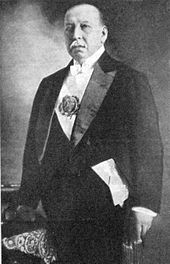Victorino de la Plaza
Victorino de la Plaza (born November 2, 1840 in Payogasta , Salta Province , Argentina ; died October 2, 1919 in Buenos Aires , Argentina) was a lawyer and Vice-President of Argentina from 1910 to 1914 and President of Argentina from 1914 to 1916 . He was the last president of the "Conservative Period" that began in 1880.
Life
He was the son of José Mariano Roque de la Plaza Elejalde and María Manuela Silva Palacios. In his childhood he worked as a tutor at a school run by Pedro Arze, selling newspapers and the candy soaps made by his mother. He began his professional career at Mariano Zorreguieta y comenzó, where he worked as a lawyer and writer. After school, he joined the army for a short time and fought in the Triple Alliance War . However, due to health problems, he had to leave it again. Then he began to study law and got the godfather Dalmacio Vélez Sarsfield to the side and wrote, as an assistant, the civil code.
Profession and Politics
De la Plaza began his professional career as a civil servant, and in 1876 he worked as President Avellaneda's finance minister . He resigned from this position in 1880 when he was elected national representative of his home province. Under the presidency of Julio Argentino Roca , he became foreign minister and minister of religion in 1882 and finance minister from 1883 to 1885. He then made a name for himself as a bank attorney and was commissioned by President Carlos Pellegrini to renegotiate the foreign debt. On October 12, 1910, he was elected Vice President of Roque Sáenz Peña . The Buenos Aires subway opened in 1913 as the 13th subway in the world and the first in South America. He took part in this event.
president
Due to health problems, Sáenz Peña applied for leave in 1913 and De la Plaza took over as Vice-President on an interim basis until Sáenz Peña died on August 9, 1914, making De la Plaza President. During his tenure, he established the National Postal Savings Fund and introduced labor protection laws. With the outbreak of World War I , exports to North America fell sharply. At first the ABC Entente planned to go to war with Brazil and Chile . After Brazil and Chile refused to go to war, the country remained neutral.
He founded the Directorate of Industry to promote the manufacture of products that could be imported from Europe. Although Argentina stayed out of the war, the UK attempted to hijack an Argentine ship. The reason for this was the assumption that Germans were on board. After it was clarified that there were no Germans on board, the ship was returned. There was a shortage of goods due to the war. Therefore, the government banned the export of scrap metal, thread and sewing thread. There was a slight improvement in the economic situation during 1916, but it remained tense.
On July 9, 1916, a shot was fired from the audience in the direction of the President during a military parade. This missed De la Plaza and the perpetrator arrested. He was found to have poor thinking and was sentenced to 16 months in prison for illegally possessing a firearm. Argentina's first free election took place in 1916. After Plaza approved the new electoral law, it was allowed to apply. He was defeated by Hipólito Yrigoyen . Victorino de la Plaza died on October 2, 1919 in Buenos Aires.
Individual evidence
- ↑ Casa Rosada: Victorino de la Plaza. In: Casarosada.gob.ar. Retrieved June 14, 2020 .
- ↑ Presidentes, Vicepresidentes, y Ministros de Economía de Argentina www.varelaenred.com.ar (archived version), accessed on June 9, 2020 (Spanish)
- ^ Botana, Natalio (2005). El orden conservador: la politica argentina entre 1880 y 1916. Buenos Aires: Cúspide
- ↑ Victorino de la Plaza Silva in www.genealogiafamiliar.net, accessed on June 9, 2020 (Spanish)
- ↑ Enciclopedia visual de la Argentina, de la A a la Z. I, AD. Diario Clarín. 2002. p. 424. ISBN 950-782-232-1
- ↑ Victorino de la Plaza: "Yo sé que vendrán caras extrañas". La sorprendente historia de los vicepresidentes argentinos (Primera edición). Buenos Aires: Vergara. ISBN 978-950-15-2423-9 .
- ↑ a b Biography of the President www.tribelectoraljujuy.gov.ar accessed on June 9, 2020 (Spanish)
- ↑ Guido, Horacio J. (1988). Secuelas del unicato. Memorial de la Patria. La Bastilla. Page 160–162
- ↑ mamut en el subte www.lanacion.com.ar, accessed on June 9, 2020 (Spanish)
- ^ Sáenz, Jimena (1988). Entre dos centenarios. Memorial de la Patria. La Bastilla pages 61-62
- ^ Círculo de Legisladores de la Nación Argentina (1999). Juan F. Cafferata: una vocación reformadora
- ↑ www.argentina-rree.com Elertrado del ABC (Argentina-Brasil-Chile) de mayo de 1915 www.argentina-rree.com, accessed on June 11, 2020 (Spanish)
- ↑ Vedøya, Juan Carlos (1978). «La captura del“ Presidente Miter ”». Todo es Historia (138).
- ↑ Presidente Victorino de www.argentinafolkloreyprovincias.es, accessed on June 9, 2020 (Spanish)
- ↑ Victorino de la Plaza www.camdipsalta.gov.ar, accessed on June 9, 2020 (Spanish)
| personal data | |
|---|---|
| SURNAME | Plaza, Victorino de la |
| BRIEF DESCRIPTION | Argentine attorney, Vice President and President of Argentina |
| DATE OF BIRTH | November 2, 1840 |
| PLACE OF BIRTH | Payogasta , Salta Province , Argentina |
| DATE OF DEATH | October 2, 1919 |
| Place of death | Buenos Aires , Argentina |
